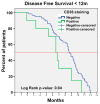Prognostic Impact of CD36 Immunohistochemical Expression in Patients with Muscle-Invasive Bladder Cancer Treated with Cystectomy and Adjuvant Chemotherapy
- PMID: 35159947
- PMCID: PMC8836680
- DOI: 10.3390/jcm11030497
Prognostic Impact of CD36 Immunohistochemical Expression in Patients with Muscle-Invasive Bladder Cancer Treated with Cystectomy and Adjuvant Chemotherapy
Abstract
Neoadjuvant chemotherapy followed by a cystectomy is the standard treatment in muscle-invasive bladder cancer (MIBC). However, the role of chemotherapy in the adjuvant setting remains controversial, and therefore new prognostic and predictive biomarkers are needed to improve the selection of MIBC patients. While lipid metabolism has been related to several biological processes in many tumours, including bladder cancer, no metabolic biomarkers have been identified as prognostic in routine clinical practice. In this multicentre, retrospective study of 198 patients treated with cystectomy followed by platinum-based adjuvant chemotherapy, we analysed the immunohistochemical expression of CD36 and correlated our findings with clinicopathological characteristics and survival. CD36 immunostaining was positive in 30 patients (15%) and associated with more advanced pathologic stages (pT3b-T4; p = 0.015). Moreover, a trend toward lymph node involvement in CD36-positive tumours, especially in earlier disease stages (pT1-T3; p = 0.101), was also observed. Among patients with tumour progression during the first 12 months after cystectomy, disease-free survival was shorter in CD36-positive tumours than in those CD36-negative (6.51 months (95% CI 5.05-7.96) vs. 8.74 months (95% CI 8.16-9.32); p = 0.049). Our results suggest an association between CD36 immunopositivity and more aggressive features of MIBC and lead us to suggest that CD36 could well be a useful prognostic marker in MIBC.
Keywords: CD36; MIBC; adjuvant chemotherapy; bladder cancer; fatty acid; lipid metabolism; prognostic biomarker.
Conflict of interest statement
The authors declare no conflict of interest.
Figures





References
Grants and funding
LinkOut - more resources
Full Text Sources

